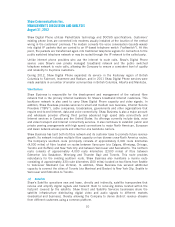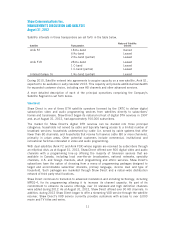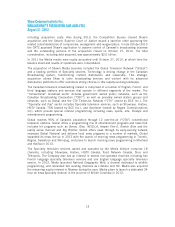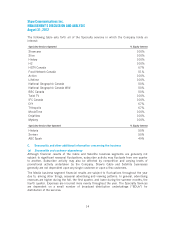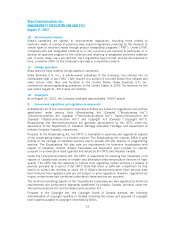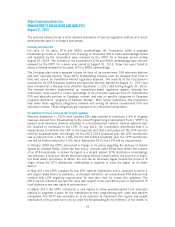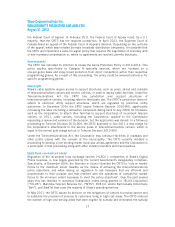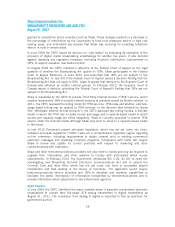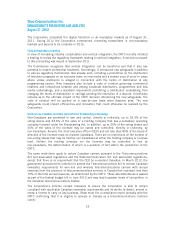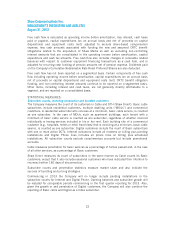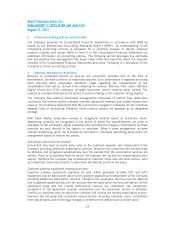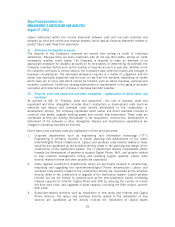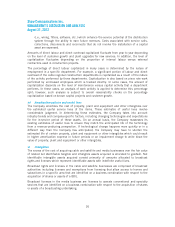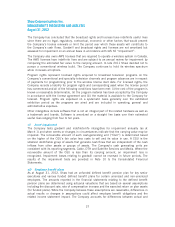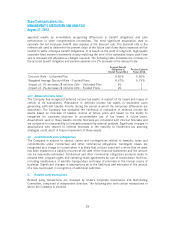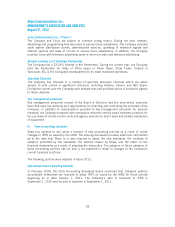Shaw 2012 Annual Report Download - page 23
Download and view the complete annual report
Please find page 23 of the 2012 Shaw annual report below. You can navigate through the pages in the report by either clicking on the pages listed below, or by using the keyword search tool below to find specific information within the annual report.Shaw Communications Inc.
MANAGEMENT’S DISCUSSION AND ANALYSIS
August 31, 2012
The Corporation completed the digital transition in all mandatory markets as of August 31,
2011. During 2012 the Corporation commenced converting transmitters in non-mandatory
markets and expects to be complete in 2016.
Vertical integration proceeding
In view of increasing industry consolidation and vertical integration, the CRTC recently initiated
a hearing to review the regulatory framework relating to vertical integration. A decision pursuant
to this proceeding was issued in September 2011.
The Commission recognizes that vertical integration can be beneficial and that it also has
potential to enable preferential treatment. Accordingly, it introduced new safeguards in addition
to various regulatory mechanisms that already exist, including a prohibition on the distribution
of television programs on an exclusive basis on new media and a reverse onus of proof in cases
where undue preference is alleged in connection with the terms of distribution of any
programming service. New measures also include a code of conduct governing commercial
relations and interactions between and among broadcast distributors, programmers and new
media undertakings, and a standstill requirement prohibiting a distribution undertaking from
changing the terms of distribution or carriage pending the resolution of a dispute. Uncertainty
remains as to the ultimate impact of the CRTC decision introducing the new safeguards. The
code of conduct will be applied on a case-by-case basis when disputes arise. The new
safeguards could impact efficiencies and innovation that could otherwise be realized by the
Corporation.
Limits on non-Canadian ownership and control for broadcasting undertakings
Non-Canadians are permitted to own and control, directly or indirectly, up to 33.3% of the
voting shares and 33.3% of the votes of a holding company that has a subsidiary operating
company licensed under the Broadcasting Act. In addition, up to 20% of the voting shares and
20% of the votes of the licensee may be owned and controlled, directly or indirectly, by
non-Canadians. As well, the chief executive officer (CEO) and not less than 80% of the board of
directors of the licensee must be resident Canadians. There are no restrictions on the number of
non-voting shares that may be held by non-Canadians at either the holding company or licensee
level. Neither the holding company nor the licensee may be controlled in fact by
non-Canadians, the determination of which is a question of fact within the jurisdiction of the
CRTC.
The same restrictions apply to certain Canadian carriers pursuant to the Telecommunications
Act and associated regulations and the Radiocommunication Act and associated regulations,
except that there is no requirement that the CEO be a resident Canadian. In March 2012, the
government announced its intention to amend the Telecommunications Act to remove Canadian
ownership requirements for wire-line and wireless telecommunications carriers with annual
revenues from the provision of telecommunications services in Canada that represent less than
10% of the total annual revenues, as determined by the CRTC. These amendments were passed
as part of the federal budget bill in June 2012 and may lead to greater levels of competition in
the Canadian telecommunications market.
The Corporation’s Articles contain measures to ensure the Corporation is able to remain
compliant with applicable Canadian ownership requirements and its ability to obtain, amend or
renew a license to carry on any business. Shaw must file a compliance report annually with the
CRTC confirming that it is eligible to operate in Canada as a telecommunications common
carrier.
19



